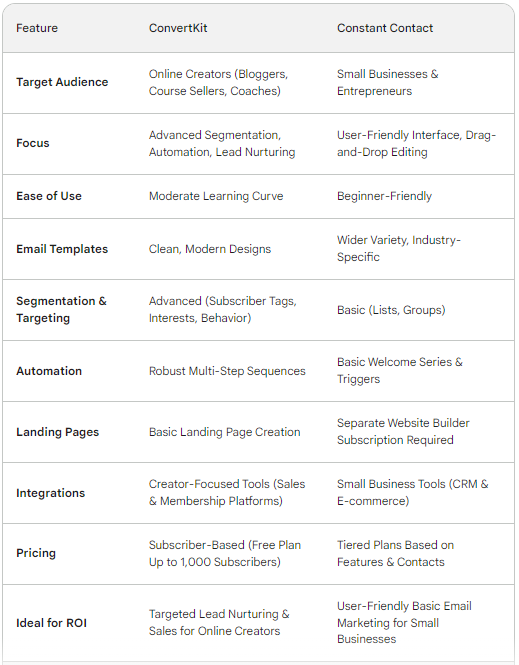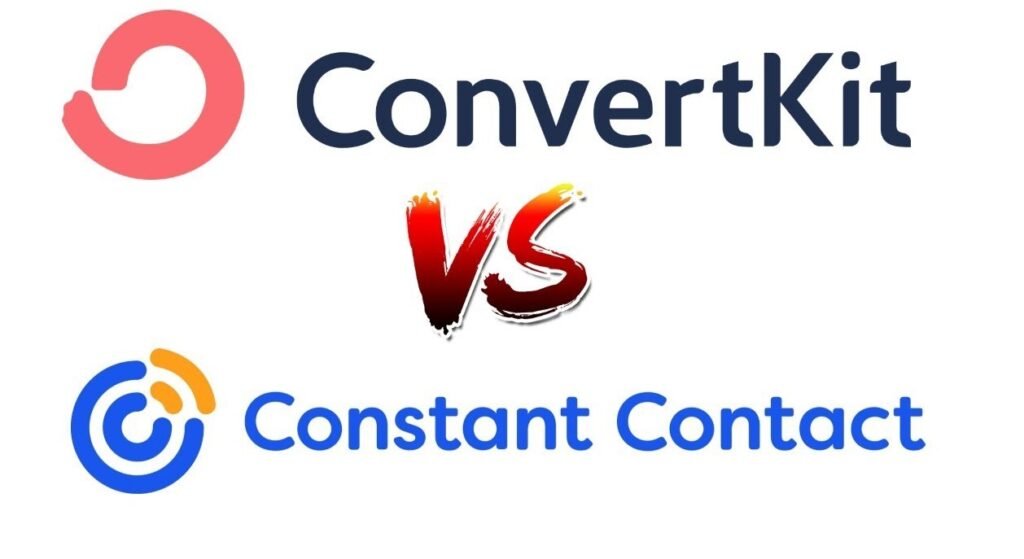In today’s digital landscape, email marketing remains a powerful tool for nurturing leads, driving conversions, and fostering customer loyalty. But with a plethora of email marketing platforms available, choosing the right one can be a daunting task. Two industry leaders, ConvertKit and Constant Contact, often come to the forefront. This article delves into a comprehensive comparison of ConvertKit vs Constant Contact, to help you determine which platform offers a better return on investment (ROI) for your specific needs.
Target Audience and Feature Focus
ConvertKit: Caters primarily to online creators, bloggers, course sellers, and coaches. Its core strength lies in advanced segmentation, subscriber tagging, and automation features designed to nurture leads effectively and convert them into paying customers.
Constant Contact: Primarily targets small businesses and entrepreneurs seeking a user-friendly platform for basic email marketing needs. It offers drag-and-drop email creation tools, pre-built templates, and basic analytics to manage email campaigns efficiently.
Choosing the Right Platform:
Consider your email marketing goals and target audience. If you’re an online creator focused on building relationships and segmenting your audience for targeted messaging, ConvertKit might be a better fit. Conversely, if you’re a small business owner seeking a user-friendly platform for basic email broadcasts and list management, Constant Contact could be a good choice.
Feature Breakdown: ConvertKit vs Constant Contact
Here’s a head-to-head comparison of some key features to help you decide between ConvertKit and Constant Contact:
Ease of Use: Constant Contact boasts a user-friendly interface with drag-and-drop email creation and pre-built templates, making it ideal for beginners. ConvertKit offers a steeper learning curve, with a focus on advanced functionalities that might require a more technical understanding.
Email Templates: Both platforms offer pre-built templates to jumpstart your email campaigns. Constant Contact provides a wider variety of industry-specific templates, while ConvertKit focuses on clean and modern designs.
Segmentation and Targeting: ConvertKit shines in this area, allowing for advanced segmentation based on subscriber tags, interests, and behavior. Constant Contact offers basic segmentation options, but may not be suitable for complex audience targeting strategies.
Automation: Both platforms offer email automation features. ConvertKit’s automation capabilities are more robust, allowing you to create multi-step sequences based on subscriber behavior and preferences. Constant Contact’s automation features are more basic, focusing on welcome sequences and basic triggers.
Landing Pages: ConvertKit offers basic landing page creation functionalities within its plans. Constant Contact requires a separate subscription for its website builder tool to create landing pages.
Integrations: Both platforms integrate with popular third-party tools and services. However, ConvertKit caters more towards integrations relevant to online creators, such as sales and membership platforms. Constant Contact offers integrations geared towards small businesses, such as CRM and e-commerce tools.
Pricing: ConvertKit’s pricing is based on the number of subscribers, with a free plan for up to 1,000 subscribers. Constant Contact offers tiered plans based on features and number of contacts.
Choosing Based on ROI:
While pricing is a factor, ROI goes beyond the initial cost. Here’s how to assess ROI for each platform:
ConvertKit: If you can leverage its advanced segmentation and automation features to nurture leads and drive targeted sales, ConvertKit can deliver a high ROI. However, if you don’t require these functionalities, its value proposition might be diminished.
Constant Contact: For small businesses focused on basic email broadcasts and list management, Constant Contact can offer a good ROI with its user-friendly interface and affordable pricing. However, if you require advanced targeting and automation, the platform might not justify its cost in the long run.

Conclusion: Selecting the Winner – ROI for Your Specific Needs
Ultimately, the “winner” between ConvertKit and Constant Contact depends on your specific needs and budget. Here’s a quick recap:
Choose ConvertKit if: You’re an online creator focused on lead nurturing, segmentation, and advanced automation.
Choose Constant Contact if: You’re a small business owner seeking a user-friendly platform for basic email marketing needs.
By carefully considering your target audience, email marketing goals, and budget, you can select the platform that delivers the best ROI for your business. Remember, a free trial offered by both platforms can be a great way to test-drive their features and see which one resonates better with your workflow.

